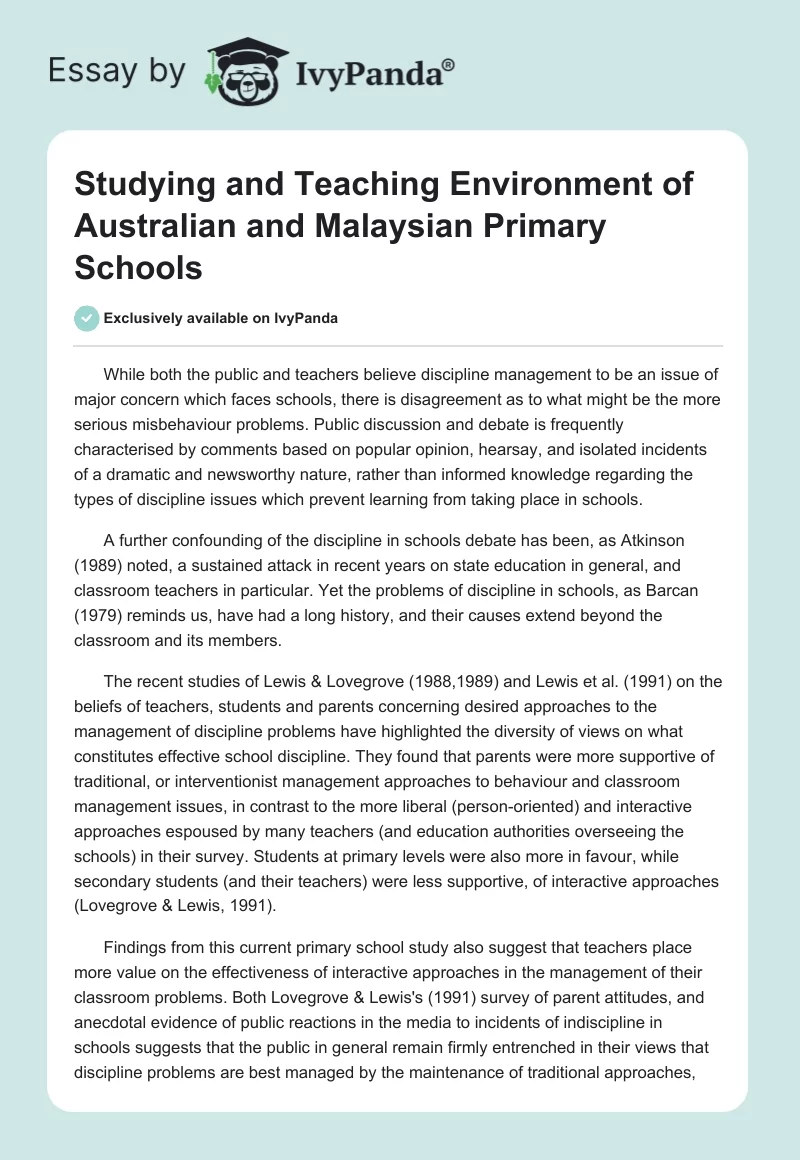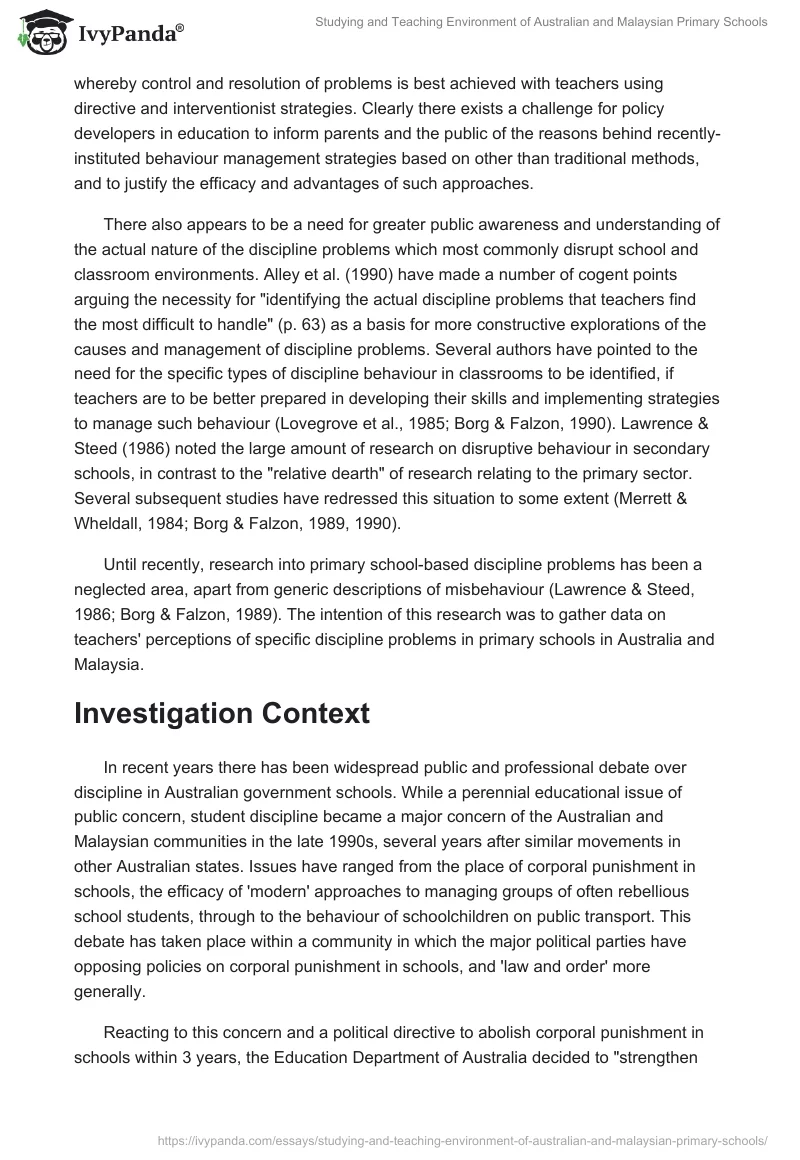While both the public and teachers believe discipline management to be an issue of major concern which faces schools, there is disagreement as to what might be the more serious misbehaviour problems. Public discussion and debate is frequently characterised by comments based on popular opinion, hearsay, and isolated incidents of a dramatic and newsworthy nature, rather than informed knowledge regarding the types of discipline issues which prevent learning from taking place in schools.
A further confounding of the discipline in schools debate has been, as Atkinson (1989) noted, a sustained attack in recent years on state education in general, and classroom teachers in particular. Yet the problems of discipline in schools, as Barcan (1979) reminds us, have had a long history, and their causes extend beyond the classroom and its members.
The recent studies of Lewis & Lovegrove (1988,1989) and Lewis et al. (1991) on the beliefs of teachers, students and parents concerning desired approaches to the management of discipline problems have highlighted the diversity of views on what constitutes effective school discipline. They found that parents were more supportive of traditional, or interventionist management approaches to behaviour and classroom management issues, in contrast to the more liberal (person-oriented) and interactive approaches espoused by many teachers (and education authorities overseeing the schools) in their survey. Students at primary levels were also more in favour, while secondary students (and their teachers) were less supportive, of interactive approaches (Lovegrove & Lewis, 1991).
Findings from this current primary school study also suggest that teachers place more value on the effectiveness of interactive approaches in the management of their classroom problems. Both Lovegrove & Lewis’s (1991) survey of parent attitudes, and anecdotal evidence of public reactions in the media to incidents of indiscipline in schools suggests that the public in general remain firmly entrenched in their views that discipline problems are best managed by the maintenance of traditional approaches, whereby control and resolution of problems is best achieved with teachers using directive and interventionist strategies. Clearly there exists a challenge for policy developers in education to inform parents and the public of the reasons behind recently-instituted behaviour management strategies based on other than traditional methods, and to justify the efficacy and advantages of such approaches.
There also appears to be a need for greater public awareness and understanding of the actual nature of the discipline problems which most commonly disrupt school and classroom environments. Alley et al. (1990) have made a number of cogent points arguing the necessity for “identifying the actual discipline problems that teachers find the most difficult to handle” (p. 63) as a basis for more constructive explorations of the causes and management of discipline problems. Several authors have pointed to the need for the specific types of discipline behaviour in classrooms to be identified, if teachers are to be better prepared in developing their skills and implementing strategies to manage such behaviour (Lovegrove et al., 1985; Borg & Falzon, 1990). Lawrence & Steed (1986) noted the large amount of research on disruptive behaviour in secondary schools, in contrast to the “relative dearth” of research relating to the primary sector. Several subsequent studies have redressed this situation to some extent (Merrett & Wheldall, 1984; Borg & Falzon, 1989, 1990).
Until recently, research into primary school-based discipline problems has been a neglected area, apart from generic descriptions of misbehaviour (Lawrence & Steed, 1986; Borg & Falzon, 1989). The intention of this research was to gather data on teachers’ perceptions of specific discipline problems in primary schools in Australia and Malaysia.
Investigation Context
In recent years there has been widespread public and professional debate over discipline in Australian government schools. While a perennial educational issue of public concern, student discipline became a major concern of the Australian and Malaysian communities in the late 1990s, several years after similar movements in other Australian states. Issues have ranged from the place of corporal punishment in schools, the efficacy of ‘modern’ approaches to managing groups of often rebellious school students, through to the behaviour of schoolchildren on public transport. This debate has taken place within a community in which the major political parties have opposing policies on corporal punishment in schools, and ‘law and order’ more generally.
Reacting to this concern and a political directive to abolish corporal punishment in schools within 3 years, the Education Department of Australia decided to “strengthen support for schools” in the area of school discipline in its influential Three Year Plan for government schools. The justification for increased ‘support’ to schools was that all children need a “safe and secure learning environment” that allows teachers to “get on with the job of teaching” (Education Department of Australia, 1989a). The question of whether or not teachers were, in fact, being prevented from “getting on with the job of teaching” by disruptive and poorly disciplined students, was not addressed.
Late in 1989, the Director General of Education and the Minister of Education in Australia jointly launched School Discipline: policy and guidelines for practice, a comprehensive and assertive statement on student discipline intended to “guide” school communities in the development of “school based discipline policy” (Education Department of Australia, 1989b).
Because of the politicisation of the student discipline issue, significant questions about student behaviour in government schools have remained largely unasked, let alone thoroughly addressed through empirical inquiry. As there was a lack of research in the area, it was decided to undertake a major study of teachers’ views on discipline in schools. The principal focus of the study was to review teacher attitudes and practices in the area of student behaviour management in Malaysian primary schools.
The study was influenced by the work undertaken by members of the Educational Research Centre at Sheffield University. Their report, Teachers and Discipline, was commissioned as part of the Elton Enquiry into Discipline in Schools (England and Wales) which was released in 1989 (Department of Education and Science, 1989). Negotiation with the research team in mid-1989 resulted in the survey instrument being released for a comparable study in government schools in Adelaide, the largest city in Australia. It was necessary to revise substantially sections of the questionnaire to comply with the specific characteristics of the Australian and Malaysian educational settings. This process included a trailing phase with a representative group of teachers.
References
ALLEY, R., O’HAIR, M. & WRIGHT, R. (1990) Student misbehaviours: which ones really trouble teachers? Teacher Education Quarterly, Summer.
ATKINSON, J. (1989) Responding to Elton: a whole school approach, Support for Learning, 4(4), pp. 242-248.
BARCAN, A. (1979) Discipline in N.S.W. Schools (New South Wales, NSW Committee of Inquiry into Pupil and Discipline in Schools).
BORG, M.G. & FALZON, J.M. (1989) Primary school teachers’ perception of pupils’ undesirable behaviours, Education Studies, 15, pp. 251-260.
BORG, M.G. & FALZON, J.M. (1990) Primary school teachers’ perception of pupils’ undesirable behaviours: the effects of teaching experience, pupil’s age, sex and ability stream, British Journal of Educational Psychology, 60, pp. 220-226.
DEPARTMENT OF EDUCATION AND SCIENCE (1989) Discipline in Schools (England and Wales) (London, HMSO).
EDUCATION DEPARTMENT OF AUSTRALIA (1989a) Three Year Plan (Adelaide, Government Printer).
EDUCATION DEPARTMENT OF AUSTRALIA (1989b) School Discipline: policy and guidelines for practice (Adelaide, Government Printer).
EDUCATION DEPARTMENT OF AUSTRALIA (1990) Student Census: July 1990 (Adelaide, Statistics Unit).
LEWIS, R. & LOVEGROVE, M.N. (1988) Students’ views on how teachers are disciplining class-rooms, in: R. SLEE (Ed.) (1988) Discipline in Schools: a curriculum perspective (Macmillan)
LEWIS, R. & LOVEGROVE, M.N. (1989) Parents’ attitudes to classroom discipline, Journal of Australian Studies, 25, pp. 11-22.
LEWIS, R., LOVEGROVE, M.N. & BURMAN, E. (1991) Teachers’ perceptions of ideal classroom disciplinary practices, in: M.N. LOVEGROVE & R. LEWIS (Ed.) Classroom Discipline (Melbourne, Longman Cheshire).
LOVEGROVE, M.N., LEWIS, R., FALL, C. & LOVEGROVE, H. (1985) Students’ preferences for discipline practices in schools, Teaching and Teacher Education, 1(4), pp. 325-333.
LOVEGROVE, M.N. & LEWIS, R. (Eds) (1991) Classroom Discipline, (Melbourne, Longman Cheshire.
MERRETT, F. & WHELDALL, K. (1984) Classroom behaviour problems which junior primary school teachers find most troublesome, Educational Studies, 10(2), pp. 87-92.
STEED, D. (1985) Disruptive pupils, disruptive Schools: Which is the chicken? Which is the egg? Teachers? Teacher Education Quarterly, Summer,.
WHELDALL, K. & MERRETT, F. (1988) Which classroom behaviours do primary school teachers say they find most troublesome? Educational Review, 40(1), pp. 13-27.


